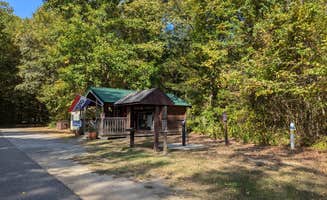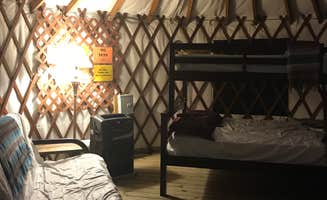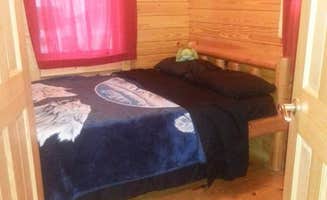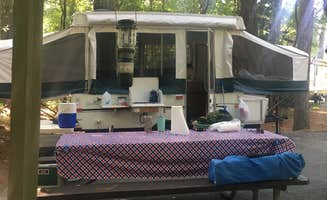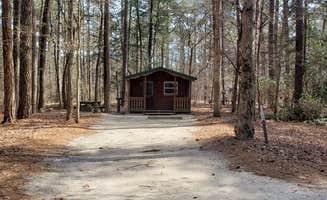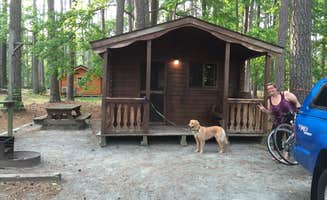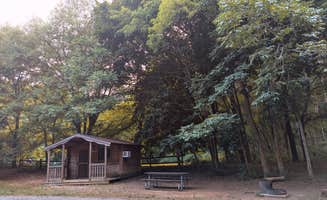Glamping near Trappe, Maryland provides easy access to the Chesapeake's eastern shore region where elevations rarely exceed 100 feet, creating ideal waterfront camping conditions. The area experiences humid summers with temperatures averaging 87°F in July and August, while spring and fall bring milder temperatures that many campers prefer. Mosquitoes and biting flies can be prevalent from June through August, especially near water.
What to do
Kayaking through water trails: At Janes Island State Park Campground, the water trails offer varying experiences from wide channels to narrow marsh routes. "Great kayaking to Jane's Island. Very clean bathrooms. Very family oriented. Rangers are nice and so are the camp hosts," reports John Z. The park has well-marked kayaking trails accessible directly from the campground.
Hiking forest trails: The trail system at Tuckahoe State Park Campground provides opportunities for various outdoor activities. "Lots of trails to hike. Beautiful, peaceful. Some sites not level," notes Shawn. The park maintains 20 miles of trails that are also open for biking and horseback riding.
Fishing freshwater spots: Fishing options abound at multiple parks in the region. "Though I live in Texas now, Maryland will always be home for me. Whenever I get the chance to head back, I almost make sure to check out some of the local fishing spots," shares Sam D. about Martinak State Park. The Choptank River and nearby creeks are known for bass, catfish, and perch.
Paddling cypress trees: The unique bald cypress trees create a distinctive paddling experience. "We also rented a kayak; awesome activity to do around the lake," says James P. about Trap Pond State Park Campground. Paddlers can navigate through stands of northernmost naturally-growing bald cypress trees in the United States.
What campers like
Waterfront access: Many campers appreciate the direct water access at Roaring Point Waterfront Campground. "Nothing fancy but beautiful setting. Great people to work with," explains Kris L. The campground sits directly on the Nanticoke River with boat launch facilities and swimming areas.
Spacious campsites: Site separation and privacy rank high on campers' priority lists. "Sites were well spaced apart and good sizes," notes one reviewer. At Tuckahoe State Park, "The sites are laid out in a circle with the bathhouse in the center," as described by Jessica K., providing a convenient arrangement.
Clean facilities: Bathhouse cleanliness consistently receives positive mentions. "Bathhouses were like brand new," reports one camper. Another visitor to Trap Pond notes, "Bath house is in very nice condition," highlighting the importance of well-maintained facilities to the glamping experience.
Free bike rentals: Some parks offer complimentary bicycle use. "Bike rentals are free (donations accepted), there are several hiking/biking/horse trails," mentions Lee D. about Trap Pond State Park. This amenity allows campers to explore more of the parks without bringing their own equipment.
What you should know
Seasonal considerations: The camping season at most parks runs from March through November, with limited year-round options. "Glamping season typically runs March through November, with some luxury outdoor accommodations available year-round depending on the specific park," notes official information.
Insect preparation: Biting insects can impact comfort, especially in summer months. "Unfortunately the bugs were so bad, it was nearly impossible to enjoy. No-see-ums bite all day long, bug spray helps with these. Deer flies bite from the morning sun until it's dark," warns Sarah M. about Janes Island State Park Campground.
Site selection: Research individual sites before booking as quality varies within campgrounds. "We booked site 21, blind. The web site does not say site 21 is extremely small. We have a 25' camper, and it barely fit," cautions Buck P. about Tuckahoe State Park. Many campgrounds provide site-specific details online.
Local supplies: Most parks have limited store hours or minimal supplies. "They have a small camper store/office that closed shortly after our arrival," notes one camper. Plan to bring essential supplies or know where nearby towns with services are located.
Tips for camping with families
Playground access: Consider site proximity to play areas when booking. "For kids, there's a simple swingset in the loop and a larger, newer playground. Firewood available," explains Jean C. at Martinak State Park. Sites closer to playgrounds provide convenience but may experience more foot traffic and noise.
Educational opportunities: Many parks offer nature programs specifically designed for children. "If you're looking to learn and explore with your kids, there is an extensive junior ranger program," mentions the same reviewer about Martinak State Park Campground.
Water activities: Kid-friendly water options vary by park. "We had a great time with our 3 little ones. They have lots of easily walked trails. Bath houses are kept clean. They have quite a few playgrounds throughout the park, which was a major plus for us," shares Bill F. about Martinak State Park.
Safety considerations: Parks maintain regular ranger patrols for security. "Cell service (T-Mobile) was spotty at times, bathhouses were fine, and the ranger was on patrol regularly. We felt very safe!" reports Shanna S. This provides peace of mind for families with children.
Tips from RVers
Site leveling: Many sites require work to achieve proper leveling. "Sites are fairly spacious and have an interesting semi-circle pull through layout so backing in not required. They are not level and have a sandy base so it took a bit of work to finally get the rig level," notes Jim G. about Trap Pond State Park Campground.
Hookup limitations: Water and electric hookups are standard, but sewer connections are rare. "Sites have 30A electric and water with a nearby convenient dump station," explains the same reviewer about Trap Pond. Plan accordingly for stays longer than a few days.
Size restrictions: Larger rigs face challenges at some campgrounds. "RV sites are very tight. Anything over 35' in my opinion will be hard to get into sites," warns Jason B. about Pocomoke River State Park. Research site dimensions before booking for rigs over 30 feet.
Dump station accessibility: Most parks provide dump stations at entrance areas. "Good dump station and potable water fill. Spigots throughout the campground," notes Adam and Suzanne B. about Tuckahoe State Park. This allows for fresh water fill and waste disposal when entering or exiting.



